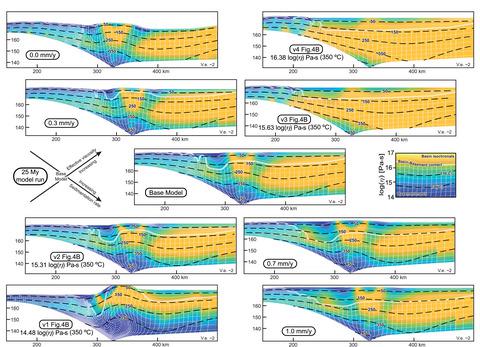当前位置:
X-MOL 学术
›
Basin Res.
›
论文详情
Our official English website, www.x-mol.net, welcomes your
feedback! (Note: you will need to create a separate account there.)
Sedimentation and viscosity controls on forearc high growth
Basin Research ( IF 2.8 ) Pub Date : 2020-10-24 , DOI: 10.1111/bre.12518 David Fernández‐Blanco 1 , Utsav Mannu 2 , Teodoro Cassola 3 , Giovanni Bertotti 4 , Sean D. Willett 1
Basin Research ( IF 2.8 ) Pub Date : 2020-10-24 , DOI: 10.1111/bre.12518 David Fernández‐Blanco 1 , Utsav Mannu 2 , Teodoro Cassola 3 , Giovanni Bertotti 4 , Sean D. Willett 1
Affiliation

|
Crustal rheology and surface processes strongly influence strain distribution and shape of orogenic wedges at their front but how they influence the wedge rear is still unclear. Here, we analyze the coupled control of viscosity and sedimentation on forearc high growth during advanced stages of subduction accretion. We use 2D thermo-mechanical finite element models constrained with data of the south Anatolian margin. Our simulations show that forearc highs grow as a thermally-activated viscosity drop in the lower crust induces ductile deformation and viscous flow. Initial viscosity and the amount of sediments in the forearc basin control non-linearly the occurrence and timing of the thermally-activated viscosity drop, and thus of the growth of the forearc high. High sedimentation rates result in thicker forearc basins that stabilize the subduction wedge and delay the onset of uplift in the forearc high. Low viscosities promote earlier onset of forearc high uplift and lead to larger morphological variability along the subduction margin. Increasing either sedimentation rate or viscosity may prevent forearc high formation entirely. The thermo-viscous forearc highs grow at an age set by wedge thermal state as a function of accretionary flux, wedge viscosity, and synorogenic sedimentation. Our models explain vertical motions in south Anatolia and potentially in other accretionary margins, like the Lesser Antilles or Cascadia, during the formation of their broad forearc highs.
中文翻译:

前弧高生长的沉降和粘度控制
地壳流变学和表面过程强烈影响造山楔前部的应变分布和形状,但它们如何影响楔后部仍不清楚。在这里,我们分析了在俯冲增生晚期阶段对弧前高增长的粘度和沉降的耦合控制。我们使用受南安纳托利亚边缘数据约束的二维热机械有限元模型。我们的模拟表明,弧前高点随着下地壳中的热激活粘度下降而增加,从而引起延性变形和粘性流动。弧前盆地的初始粘度和沉积物数量非线性地控制着热激活粘度下降的发生和时间,从而控制弧前高压的增长。高沉积速率导致更厚的弧前盆地稳定俯冲楔并延迟弧前高位隆起的开始。低粘度促进了弧前高抬升的早期发生,并导致沿俯冲边缘更大的形态变异。增加沉降速率或粘度可以完全防止前弧高的形成。热粘性前弧高点在楔形热状态设定的年龄增长,作为增生通量、楔形粘性和共生沉积的函数。我们的模型解释了在南安纳托利亚和其他增生边缘(如小安的列斯群岛或卡斯卡迪亚)在形成广阔的前弧高点期间的垂直运动。低粘度促进了弧前高抬升的早期发生,并导致沿俯冲边缘更大的形态变异。增加沉降速率或粘度可以完全防止前弧高的形成。热粘性前弧高点在楔形热状态设定的年龄增长,作为增生通量、楔形粘性和共生沉积的函数。我们的模型解释了在南安纳托利亚和其他增生边缘(如小安的列斯群岛或卡斯卡迪亚)在形成广阔的前弧高点期间的垂直运动。低粘度促进了弧前高抬升的早期发生,并导致沿俯冲边缘更大的形态变异。增加沉降速率或粘度可以完全防止前弧高的形成。热粘性前弧高点在楔形热状态设定的年龄增长,作为增生通量、楔形粘性和共生沉积的函数。我们的模型解释了在南安纳托利亚和其他增生边缘(如小安的列斯群岛或卡斯卡迪亚)在形成广阔的前弧高点期间的垂直运动。和同源沉积。我们的模型解释了在南安纳托利亚和其他增生边缘(如小安的列斯群岛或卡斯卡迪亚)在形成广阔的前弧高点期间的垂直运动。和同源沉积。我们的模型解释了在南安纳托利亚和其他增生边缘(如小安的列斯群岛或卡斯卡迪亚)在形成广阔的前弧高点期间的垂直运动。
更新日期:2020-10-24
中文翻译:

前弧高生长的沉降和粘度控制
地壳流变学和表面过程强烈影响造山楔前部的应变分布和形状,但它们如何影响楔后部仍不清楚。在这里,我们分析了在俯冲增生晚期阶段对弧前高增长的粘度和沉降的耦合控制。我们使用受南安纳托利亚边缘数据约束的二维热机械有限元模型。我们的模拟表明,弧前高点随着下地壳中的热激活粘度下降而增加,从而引起延性变形和粘性流动。弧前盆地的初始粘度和沉积物数量非线性地控制着热激活粘度下降的发生和时间,从而控制弧前高压的增长。高沉积速率导致更厚的弧前盆地稳定俯冲楔并延迟弧前高位隆起的开始。低粘度促进了弧前高抬升的早期发生,并导致沿俯冲边缘更大的形态变异。增加沉降速率或粘度可以完全防止前弧高的形成。热粘性前弧高点在楔形热状态设定的年龄增长,作为增生通量、楔形粘性和共生沉积的函数。我们的模型解释了在南安纳托利亚和其他增生边缘(如小安的列斯群岛或卡斯卡迪亚)在形成广阔的前弧高点期间的垂直运动。低粘度促进了弧前高抬升的早期发生,并导致沿俯冲边缘更大的形态变异。增加沉降速率或粘度可以完全防止前弧高的形成。热粘性前弧高点在楔形热状态设定的年龄增长,作为增生通量、楔形粘性和共生沉积的函数。我们的模型解释了在南安纳托利亚和其他增生边缘(如小安的列斯群岛或卡斯卡迪亚)在形成广阔的前弧高点期间的垂直运动。低粘度促进了弧前高抬升的早期发生,并导致沿俯冲边缘更大的形态变异。增加沉降速率或粘度可以完全防止前弧高的形成。热粘性前弧高点在楔形热状态设定的年龄增长,作为增生通量、楔形粘性和共生沉积的函数。我们的模型解释了在南安纳托利亚和其他增生边缘(如小安的列斯群岛或卡斯卡迪亚)在形成广阔的前弧高点期间的垂直运动。和同源沉积。我们的模型解释了在南安纳托利亚和其他增生边缘(如小安的列斯群岛或卡斯卡迪亚)在形成广阔的前弧高点期间的垂直运动。和同源沉积。我们的模型解释了在南安纳托利亚和其他增生边缘(如小安的列斯群岛或卡斯卡迪亚)在形成广阔的前弧高点期间的垂直运动。











































 京公网安备 11010802027423号
京公网安备 11010802027423号